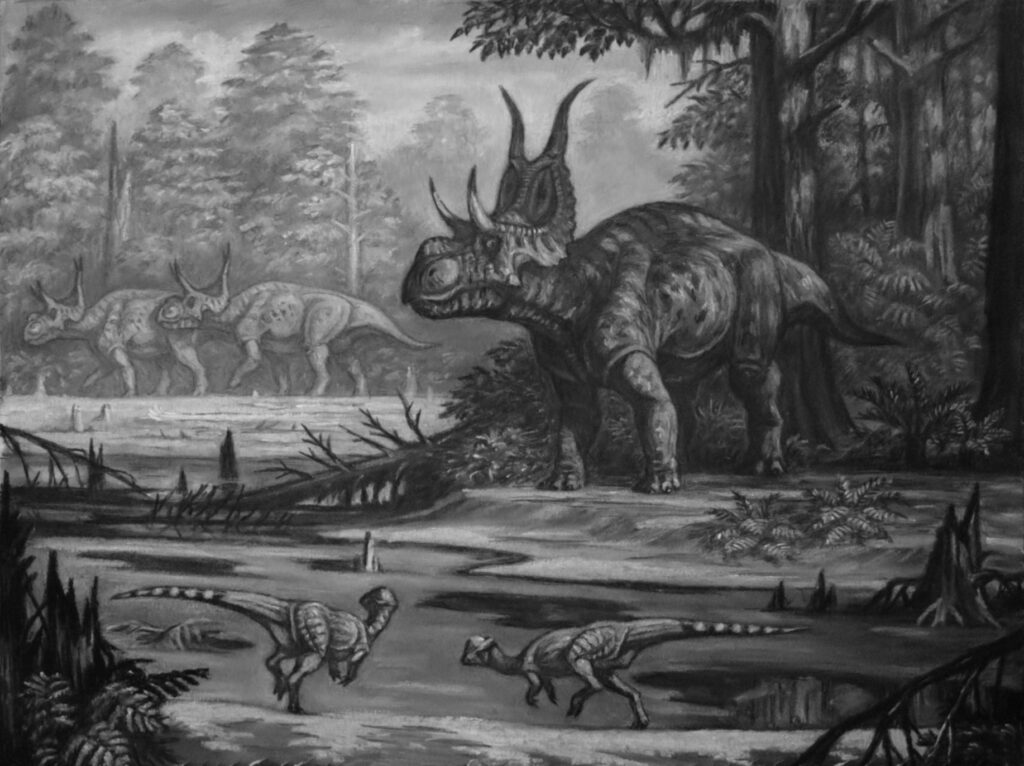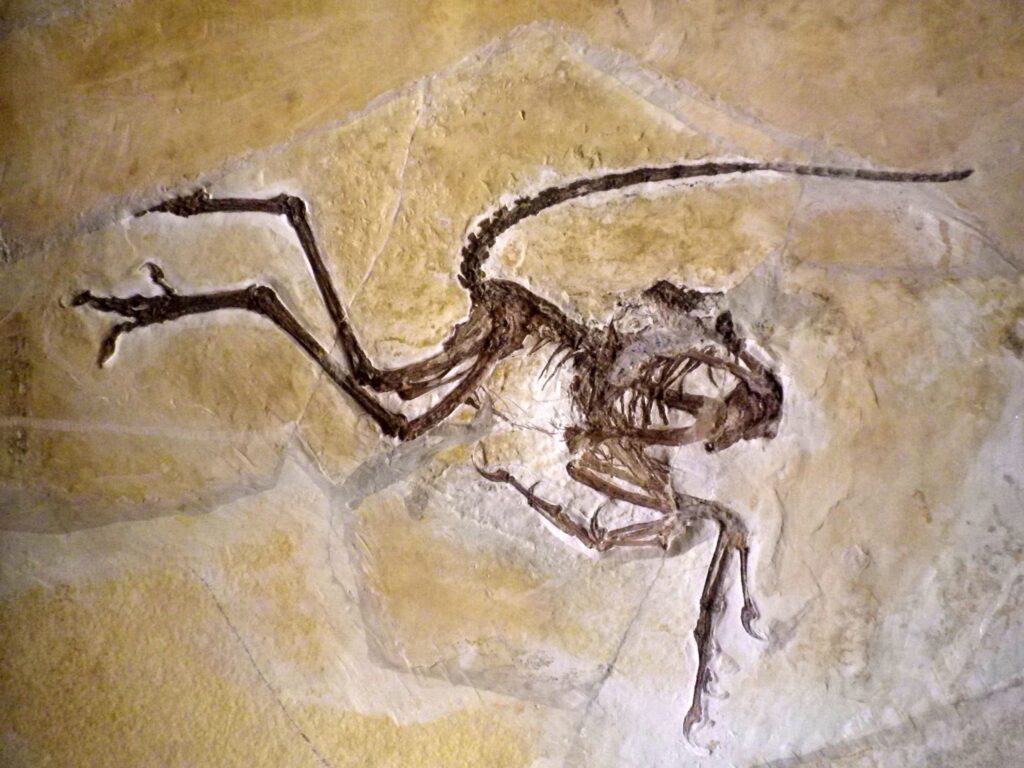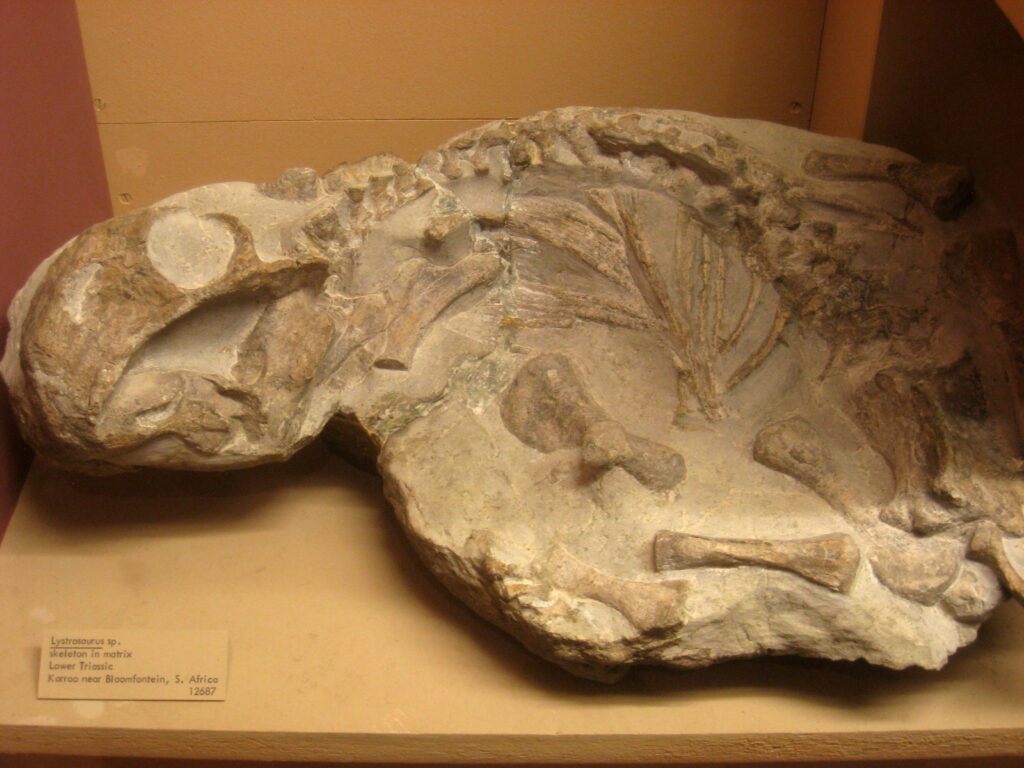The ancient landscapes of North America once trembled under the footsteps of countless dinosaur species, each with unique adaptations that have fascinated paleontologists for generations. Among these prehistoric creatures, few capture the imagination quite like Diabloceratops, a ceratopsian dinosaur whose name translates to “devil-horned face.” Discovered relatively recently in the sun-baked terrain of southern Utah, this distinctive herbivore has added important pieces to our understanding of dinosaur evolution in the Late Cretaceous period. With its elaborate frill adorned with imposing spikes and forward-facing horns, Diabloceratops represents a fascinating transitional form in ceratopsian evolution, offering scientists valuable insights into how these iconic horned dinosaurs developed their remarkable defensive features. This article explores the discovery, physical characteristics, evolutionary significance, and ancient world of this devilish-looking dinosaur from the American Southwest.
Discovery and Naming of Diabloceratops
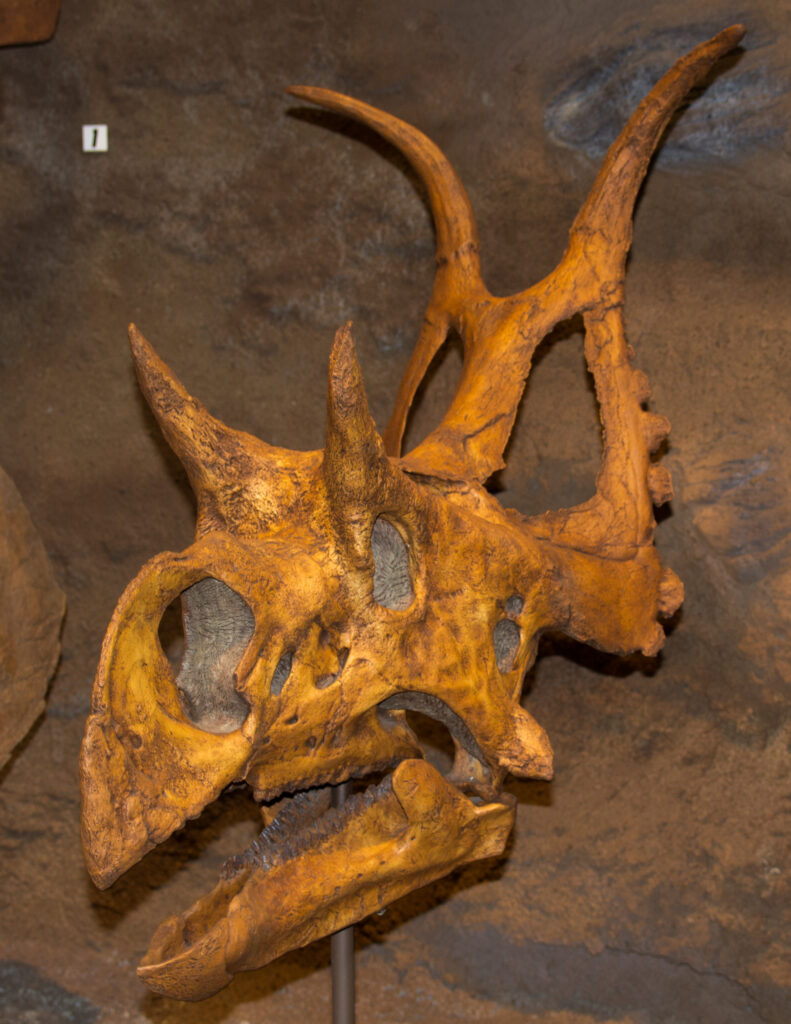
Diabloceratops entered the scientific record relatively recently compared to many dinosaur species, with the first remains discovered in 2002 within the Wahweap Formation of the Grand Staircase-Escalante National Monument in southern Utah. Paleontologist James Kirkland led the team that unearthed this significant find, and the genus was formally described and named in 2010. The name Diabloceratops combines the Spanish word “diablo” (devil) with the Greek “ceratops” (horned face), directly referencing the distinctive and somewhat menacing appearance of its cranial ornamentation. The species name, eatoni, honors Jeffrey Eaton, a paleontologist who conducted extensive research in the Grand Staircase region. Despite being discovered in the 21st century, the fossils themselves date back approximately 79 million years to the Campanian stage of the Late Cretaceous period, making Diabloceratops one of the earliest known members of the Centrosaurinae subfamily of ceratopsian dinosaurs.
Physical Characteristics and Size
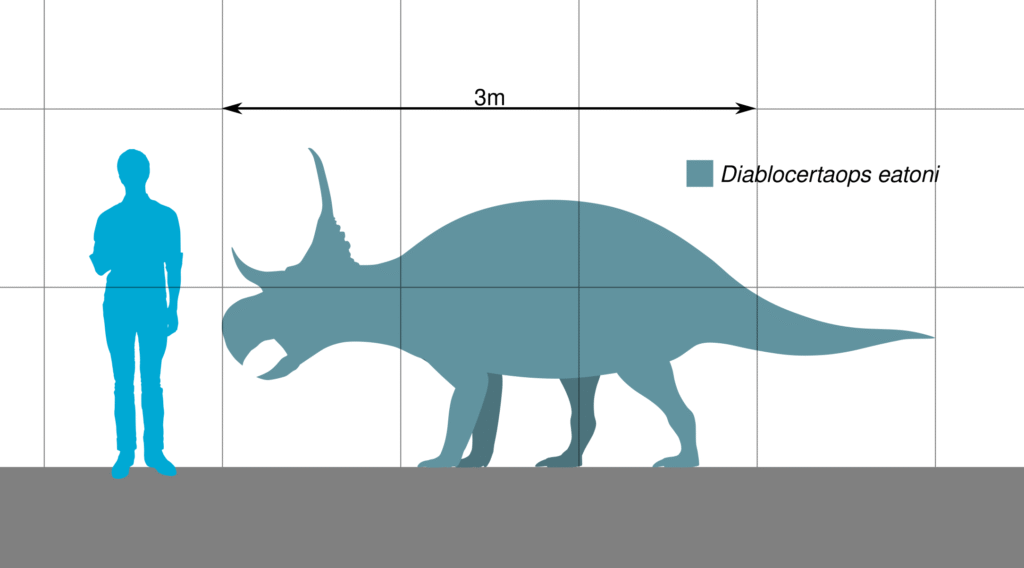
Diabloceratops was a medium-sized ceratopsian dinosaur, estimated to have reached lengths of around 15 feet (4.5 meters) from snout to tail and standing approximately 5 feet (1.5 meters) tall at the hip. Adult specimens likely weighed between 1 and 2 tons, making them substantial herbivores but not among the largest of their kind. Like other ceratopsians, Diabloceratops walked on four sturdy legs, with shorter forelimbs and longer, more powerful hind limbs, giving it a somewhat sloping posture. Its body was robust and barrel-shaped, supported by strong columnar limbs ending in hoofed toes that would have helped distribute its considerable weight. The most notable feature of Diabloceratops, however, was undoubtedly its skull, which could reach up to 6 feet (1.8 meters) in length, with nearly half of that consisting of its elaborate neck frill. This large, bony structure served multiple purposes, from species recognition and display to muscle attachment and possibly defense against predators like the tyrannosaurs that shared its environment.
The Distinctive Horned Frill

The most striking feature of Diabloceratops was its elaborate horned frill, which set it apart from many other ceratopsians and gave the dinosaur its devilish appearance. The frill extended backward from the skull, forming a shield-like structure adorned with a series of large, pointed epoccipitals (bony projections) around its margin. Particularly distinctive were the two massive, curved spikes that projected upward and outward from the top rear corners of the frill, creating a silhouette reminiscent of devil horns when viewed from certain angles. Unlike later ceratopsians such as Triceratops, which had solid frills, Diabloceratops possessed large fenestrae (openings) in its frill that would have reduced weight while maintaining structural integrity. The frill also featured unique paddle-shaped projections on either side, creating an unmistakable profile unlike any other known dinosaur. These elaborate structures were likely covered with keratin in life, the same protein found in human fingernails and rhino horns, potentially making them even more dramatic in appearance than the fossilized bone alone suggests.
Facial Horns and Beak
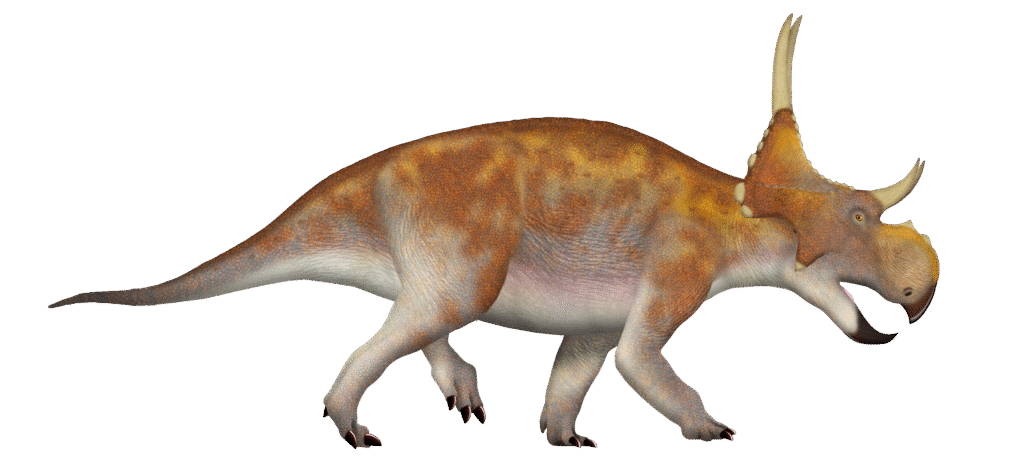
Complementing its impressive frill, Diabloceratops possessed a formidable array of facial horns that contributed to its intimidating appearance. Above each eye socket sat a substantial brow horn that curved forward and upward, measuring approximately 1 foot (30 cm) in length. These orbital horns were complemented by a shorter, but robust nasal horn positioned above the nostrils on the snout. Unlike later ceratopsians that evolved more prominent nasal horns, Diabloceratops maintained relatively equal emphasis on both its brow and nasal ornamentation, suggesting a transitional morphology in ceratopsian evolution. The front of its jaws terminated in a sharp, hooked beak similar to that of modern parrots, formed from the rostral bone and likely sheathed in keratin during life. This powerful beak worked in conjunction with batteries of shearing teeth further back in the jaws, creating an efficient feeding apparatus capable of processing tough plant material. The combination of beak, teeth, and horns created a visage that was simultaneously specialized for herbivory and potentially intimidating to would-be predators.
Evolutionary Significance
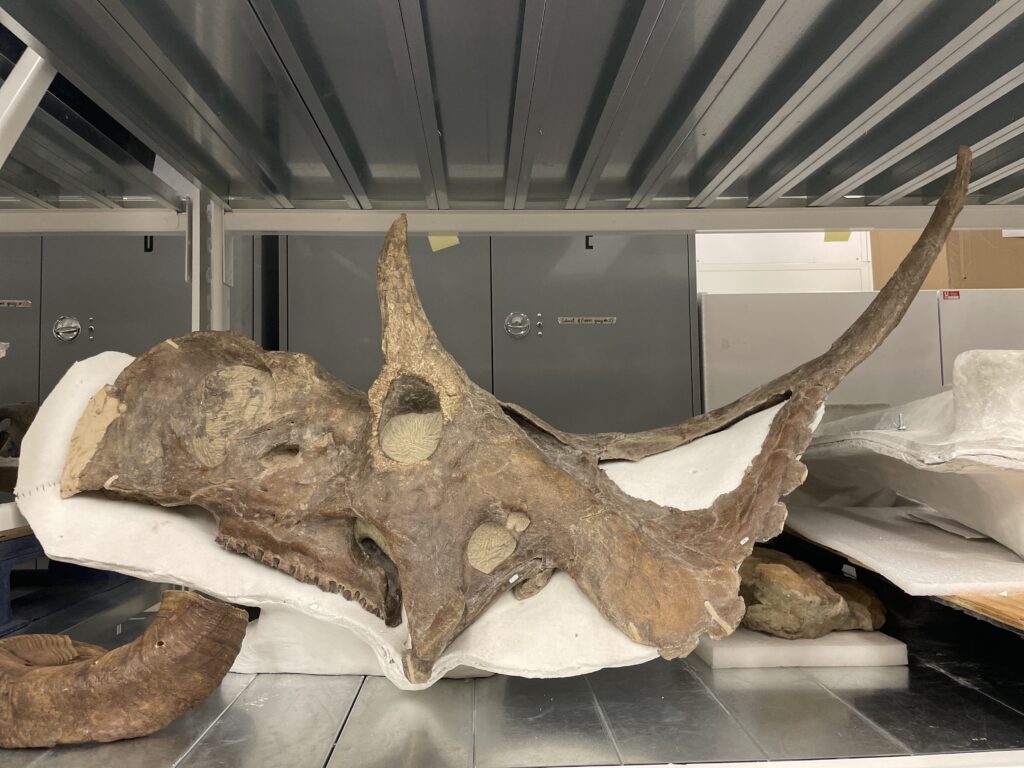
Diabloceratops holds particular importance in paleontology due to its position in ceratopsian evolutionary history, representing a transitional form between earlier, more primitive ceratopsians and the more derived later species. Dating to approximately 79 million years ago, it is among the earliest known members of the Centrosaurinae subfamily, a group characterized by more elaborate frills and generally less prominent brow horns compared to their relatives, the Chasmosaurinae (which includes Triceratops). The presence of both well-developed brow horns and frill ornamentation in Diabloceratops suggests it existed near the evolutionary split between these two major ceratopsian lineages. Its discovery has helped paleontologists better understand how the distinctive cranial features of later ceratopsians evolved. Additionally, the presence of paired epoccipital frill spikes and fenestrated frills shows that these features appeared earlier in ceratopsian evolution than previously understood, forcing scientists to reconsider the timing and pattern of character acquisition in this diverse dinosaur group.
Habitat and Environmental Context
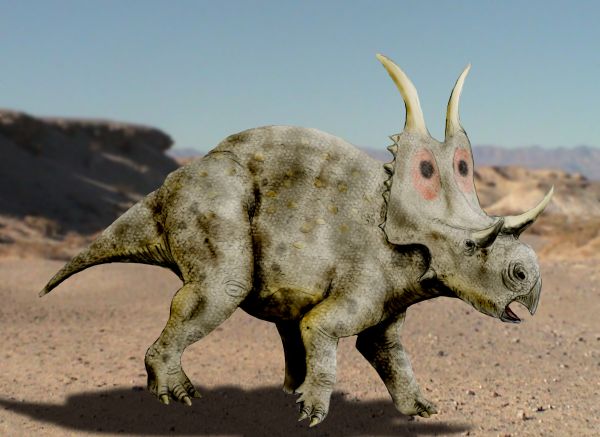
During the Late Cretaceous period, when Diabloceratops roamed, the American Southwest presented a dramatically different landscape than today’s arid deserts and canyons. The Wahweap Formation, where Diabloceratops fossils have been discovered, preserves evidence of a lush, semi-tropical coastal plain environment approximately 79 million years ago. This region formed the western edge of the Western Interior Seaway, an enormous inland sea that divided North America into two landmasses. The habitat consisted of river floodplains, swamps, and coastal marshes supporting diverse plant communities dominated by conifers, cycads, ferns, and early flowering plants. The climate was considerably warmer and more humid than modern Utah, with seasonal rainfall patterns creating a dynamic ecosystem. Diabloceratops shared this environment with a diverse assemblage of other dinosaurs, including hadrosaurs (duck-billed dinosaurs), ankylosaurs (armored dinosaurs), smaller ornithopods, and various theropod predators. The rich fossilized ecosystem preserved in the Grand Staircase-Escalante National Monument provides valuable insights into a unique biogeographic province that developed when rising sea levels isolated western North America from the eastern portions of the continent.
Diet and Feeding Behavior
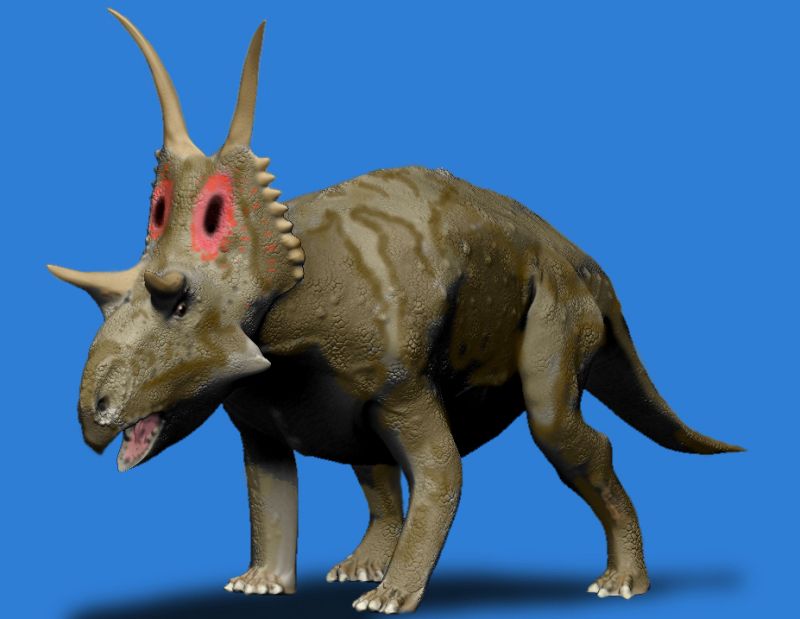
As a ceratopsian dinosaur, Diabloceratops was an obligate herbivore with specialized adaptations for processing tough plant material abundant in its Late Cretaceous environment. Its primary feeding tool was a sharp, parrot-like beak formed by the rostral bone at the front of its jaws, which would have been covered by a keratinous sheath in life. This beak functioned like botanical shears, allowing Diabloceratops to selectively crop vegetation with surprising precision. Behind this beak, Diabloceratops possessed batteries of specialized teeth arranged in continuous dental batteries, with new teeth constantly erupting to replace worn ones throughout its lifetime. These teeth had complex shearing surfaces that worked together to effectively process fibrous plant material, including cycads, ferns, and early flowering plants that dominated its ecosystem. Based on its relatively low-slung head position, Diabloceratops likely fed primarily on low-growing vegetation, using its powerful beak to clip plants before processing them with its dental batteries. The fossilized stomach contents of related ceratopsians suggest these dinosaurs may have also ingested small stones (gastroliths) to help mechanically break down tough plant fibers in their digestive tract, similar to modern birds.
Potential Social Behavior

While direct evidence of Diabloceratops social behavior remains elusive due to the limited fossil record, paleontologists can make educated inferences based on related ceratopsian dinosaurs and modern analogues. The elaborate frill and horn displays of Diabloceratops suggest these features may have served important roles in visual communication, species recognition, and potentially as signals of individual health and fitness during mating displays. Many later ceratopsians show evidence of having lived in herds, based on bone bed discoveries containing multiple individuals, and it’s reasonable to hypothesize that Diabloceratops may have exhibited similar gregarious tendencies. Living in groups would have provided numerous advantages, including enhanced protection against predators through collective vigilance and defense, more efficient foraging as multiple animals could process vegetation in an area, and greater reproductive opportunities. The distinctive frill ornamentation could have allowed individuals to recognize members of their species from a distance, an important adaptation in an ecosystem shared with other ceratopsian species. While speculative, male Diabloceratops may engage in ritualized combat using their horns to establish dominance hierarchies, similar to modern horned mammals, though this behavior would likely have been display-oriented rather than seriously injurious.
Predators and Defense Mechanisms
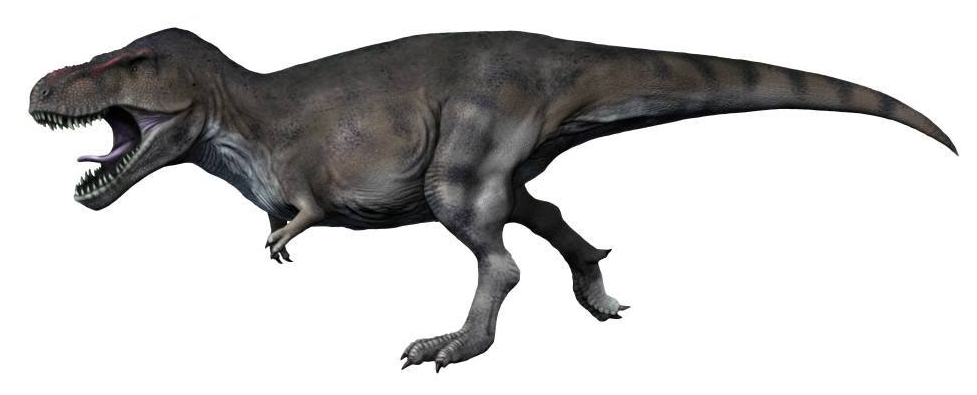
Despite its impressive size and armament, Diabloceratops faced serious threats in its Late Cretaceous environment from large theropod predators. The Wahweap Formation has yielded fossils of various tyrannosaurs and other large carnivorous dinosaurs that would have posed significant danger to Diabloceratops, particularly to younger or isolated individuals. The elaborate horns and frilled display of Diabloceratops served multiple functions, with defense likely playing a crucial role. The forward-projecting brow horns could have been effectively used to ward off attacking predators, potentially delivering serious injuries to anything that came within range. The large frill, while primarily evolved for display and species recognition, would have provided some protection for the neck region, a vulnerable target for predators. When threatened, Diabloceratops could have adopted a defensive posture, lowering its head to present its horns toward a predator while using its substantial body mass as a deterrent. The most effective defense, however, was likely social living – if Diabloceratops formed herds as many paleontologists suspect, the collective vigilance and defensive capabilities of multiple individuals would have significantly reduced predation risk, particularly for vulnerable juveniles that could shelter within the protective formation of adults.
Growth and Development
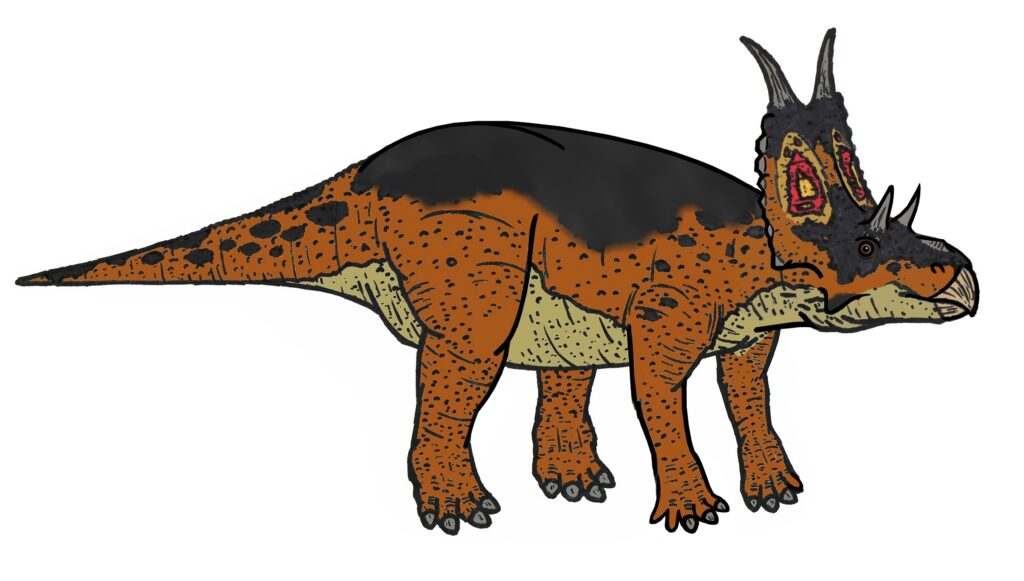
The growth patterns and life history of Diabloceratops, while not as well-documented as some better-represented dinosaur species, can be reasonably inferred from related ceratopsians for which more complete growth series have been preserved. Like other ceratopsians, Diabloceratops likely hatched from eggs laid in ground nests, emerging as relatively small and vulnerable juveniles. Young Diabloceratops would have grown rapidly during their early years, gradually developing the distinctive horns and frill that characterize the genus, though these features would have been proportionally smaller and less elaborate in juveniles. Studies of bone microstructure in related ceratopsians suggest these dinosaurs experienced rapid growth during their first 5-10 years, followed by a slower growth phase as they approached sexual maturity. The elaborate cranial ornamentation likely developed progressively throughout adolescence, potentially reaching full expression only in sexually mature adults. This pattern of delayed development of display structures is common in modern animals, where these features play roles in sexual selection and species recognition. The full lifespan of Diabloceratops remains uncertain, but comparisons with other ceratopsians suggest these animals might have lived 20-30 years under favorable conditions, with mortality primarily resulting from predation, disease, or environmental stressors rather than old age.
Scientific Importance and Research Challenges
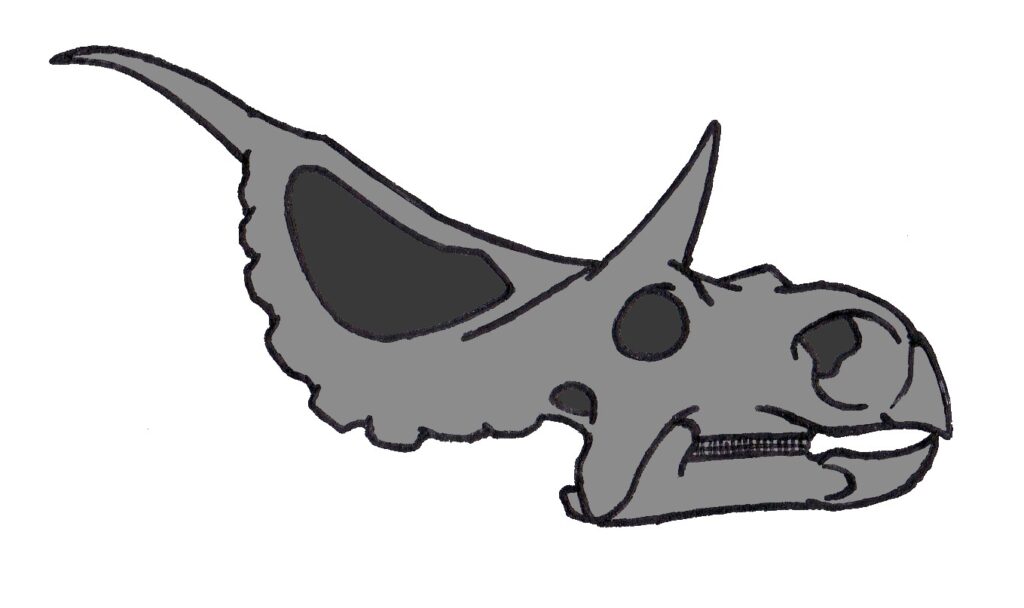
Since its formal description in 2010, Diabloceratops has assumed an important position in paleontological research, particularly in studies focused on ceratopsian evolution and diversity. As one of the earliest known centrosaurine ceratopsians, it provides a crucial data point for understanding how the elaborate cranial structures of later forms evolved over millions of years. However, research on Diabloceratops faces significant challenges, primarily stemming from the relatively limited fossil material discovered to date. The holotype specimen, while including significant portions of the skull, lacks a complete skeleton, leaving many aspects of its postcranial anatomy uncertain. The remote and rugged terrain of the Grand Staircase-Escalante National Monument, while excellent for preserving fossils, presents logistical challenges for paleontologists conducting fieldwork, limiting the pace of discoveries. Additionally, the complex taphonomic processes (conditions affecting preservation) in the Wahweap Formation mean that many fossils are found disarticulated or partially preserved, requiring painstaking preparation and analysis. Despite these challenges, ongoing research continues to refine our understanding of Diabloceratops, with each discovery potentially revealing more about its anatomy, ecology, and evolutionary relationships with other ceratopsian dinosaurs.
Cultural Impact and Public Fascination
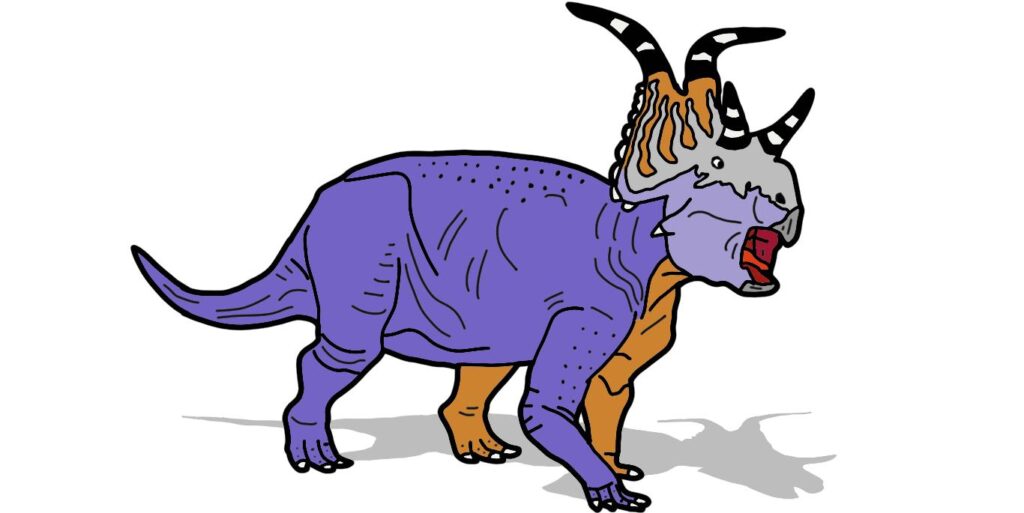
Despite being a relatively recent addition to the dinosaur roster, Diabloceratops has captured public imagination through its distinctive appearance and evocative name. The combination of its devilish horns and the inherent appeal of ceratopsian dinosaurs has made it a popular subject in paleoart, museum exhibitions, and educational materials. The dramatic silhouette of its horned frill provides a visually striking image that resonates with dinosaur enthusiasts of all ages. Several museums now feature Diabloceratops reconstructions, including the Natural History Museum of Utah, which displays material from the original specimens. The dinosaur has also appeared in various educational media, including documentaries and books about Late Cretaceous ecosystems. Perhaps most significantly, Diabloceratops serves as an ambassador for the remarkable paleontological resources preserved within Grand Staircase-Escalante National Monument, highlighting the scientific importance of this protected area. By putting a memorable face on the ancient ecosystems of the American Southwest, Diabloceratops helps the public connect with deep time and the dramatic environmental changes that have shaped our continent over millions of years, underscoring the value of paleontological research and conservation of fossil-bearing lands.
Future Discoveries and Unanswered Questions

The story of Diabloceratops remains far from complete, with numerous questions awaiting future discoveries and research. Paleontologists continue to explore the rich fossil beds of the Grand Staircase-Escalante National Monument in hopes of uncovering more complete specimens that could reveal currently unknown aspects of Diabloceratops anatomy, particularly its postcranial skeleton. Questions persist about its exact locomotion capabilities, growth rates, sensory abilities, and potential sexual dimorphism between males and females. The discovery of juvenile specimens would be particularly valuable, potentially revealing how the distinctive cranial ornamentation developed throughout the animal’s life cycle. Additional fossil material might also clarify Diabloceratops’ precise position in ceratopsian phylogeny, helping to resolve debates about its relationship to other early centrosaurines. Beyond anatomy, paleontologists seek evidence that could illuminate behavioral aspects, such as potential herding behavior, nesting strategies, or feeding preferences. The continued exploration of the Wahweap Formation may also yield insights into the paleoecology of the region, helping scientists reconstruct the ancient ecosystem in which Diabloceratops lived and the environmental factors that shaped its evolution. As research techniques advance, including CT scanning, isotope analysis, and biomechanical modeling, even existing Diabloceratops specimens may yield new insights, breathing fresh life into our understanding of this enigmatic horned dinosaur.

